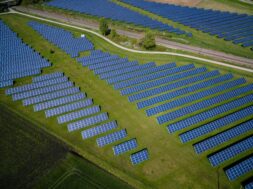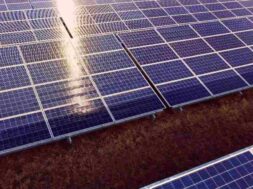
Next-generation solar power has the potential to disrupt global energy sector
HIGHLIGHTS
- The Sun is the earth’s most abundant energy source; it’s also the most widely distributed.
- The amount of solar energy hitting the earth in one hour is more than enough to power the world for one year.
- Abu Dhabi-based Irena’s new analysis finds that by 2030, countries are targeting to reach 5.4 terawatts (TW) of installed renewable power capacity.
Imagine, in the not-too-distant future, painting your wall and roof with solar power cells on all sides to turn sunlight to energy.
Yet even now, anywhere the sun shines, solar power can already run your house or city. The system keeps improving, while costs are falling. Such incremental improvements could eventually lead to a game-changing leap.
Top scientists believe the world can reach a 100 per cent renewables by or before 2050. Reasons: big drop in cost, tech improvements.
Energy disruption
Improvements in materials science — recent development of perovskite cells panels or more efficient batteries and wind turbine designs — could make it possible sooner than later.
Solar energy is a relatively low-hanging fruit. The International Renewable Energy Agency (Irena), based in Abu Dhabi, reported that solar energy has the potential to meet a significant portion of the world’s energy demand.
Solar photovoltaic (PV) technology has seen a dramatic drop in cost. Projects in the UAE have demonstrated why solar is one of the most cost-competitive sources of electricity in many parts of the world.
Enter perovskite solar cells (PSC)
Current calculations are based on existing PV technology, with efficiencies of around 20 per cent. Recent advances in perovskite, also known as metal halide perovskites (MHPs), combine extraordinary optoelectronic properties with chemical and mechanical properties not found in their semiconductor counterparts.
For instance, they exhibit power-generation properties on par with single-crystalline gallium arsenide, the solar energy cells used in most satellites. Given perovskite’s limits, innovations to get past them are advancing fast.
Perovskite offers one advantage not possible now with available PV technology: allowing building walls to be literally painted with solar cells.
One innovation involves US-based Energy Materials Corp., which partnered with Jinsong Huang of University of North Carolina at Chapel Hill to create perovskite solar cells using high-speed Kodak printers in 2021.
In 2022, for the first time, the world spent $1.1 trillion transitioning to clean power, same amount spent producing oil and gas.
“This is HUGE,” said US Secretary of Energy Jennifer Granholm, who professes to be “obsessed” with solving climate change and creating good-paying clean energy jobs.
Whether or not these developments would drive higher efficiency, cost-savings and sustainability remain to be seen.
With theoretical efficiencies of up to 40 per cent, and next-generation batteries, perovskite could turn these numbers on its head due to these major developments:
Efficiency has risen from reports of around 3 per cent in 2009 to over 25 per cent today, a lab in LA reports more than 30 per cent efficiency.
The US Department of Energy’s (DOE) SunShot Initiative aims to make solar energy cost-competitive with traditional energy sources by 2030.
In small-area lab devices, perovskite PV cells have exceeded almost all thin-film technologies (except III-V technologies) in power conversion efficiency — the rate at which light is turned into electricity — showing rapid improvements over the past five years.
Challenges for perovskite solar cells
While perovskites have rapidly increased their efficiency, a number of obstacles must still be overcome before they can be considered a viable commercial technology.
Stability, durability: Early perovskite technology decayed quickly. They go out of commission in a matter of minutes or hours. Compared to leading photovoltaic (PV) technologies, perovskites can “decompose” when they react with moisture and oxygen or when they spend extended time exposed to light, heat, or applied voltage.
Cell endurance: To create commercial perovskite solar products, cell endurance must be improved, to a level reached by traditional PV cells — with durability of up to 25 years or so. If perovskite proves a lifespan of 20 years or more, it is likely to succeed for commercial solar power generation, according to the US DOE.
Why is solar power the future power?
Solar energy is already an important source of renewable energy around the world.
Going forward, these are the reasons for its staying power:
Renewable: As long as the sun shines, we will have access to this source of energy (astronomers estimate the sun won’t run out of power for at least 4 billion more years).
Sustainable: Solar power is sustainable and can be harnessed without causing environmental harm. No greenhouse gas emissions or air pollution.
Cost-effective: The cost of solar power has decreased significantly in recent years.
Versatile: Solar power can be used to generate electricity for both small homes and large cities.
Improving technology: Advances in solar technology, such as PSC, are making solar power more efficient and effective and inexpensive than ever before.
Irena’s report, titled “Solar Power: Renewable Energy for the Grid”, noted that the deployment of solar power is accelerating: from just 40 GW in 2010 to 505 GW in 2018, a 12-fold increase. Solar Power Europe reported a doubling of installed solar generation capacity to 1.1 TW in 2022 from 2018, making it the fastest-growing source of new electricity generation capacity globally.
The report also highlights how solar energy provides power access in remote and rural areas, creating jobs and economic opportunities, and reducing greenhouse gas emissions.
> AI: Using AI and machine learning algorithms to optimise energy production and reduce waste.
How big should a solar panel farm be to power the entire earth?
That depends on several factors, including the efficiency of the solar panels, the amount of sunlight available in different regions, and the overall energy demand of the global population.
However, we can estimate the size of the solar panel farm required to power the Earth based on some assumptions and rough calculations.
According to the International Energy Agency (IAE), the total global energy consumption in 2020 was approximately 170,000 terawatt-hours (TWh).
Assuming an average solar panel efficiency of 20 per cent, a low estimate based on current technology, we can calculate that 1 square meter of solar panels can produce approximately 200 watt-hours of electricity per day.
This means that to produce 170,000 TWh of electricity per year, we would need approximately 20 trillion sqm of solar panels.
The total land area of the Earth is approximately 148,940,000 square kilometers — equivalent to 148.94 trillion sqm. About 13.5% of the Earth’s land area should be covered with solar panels to generate enough electricity to power the entire planet.
It’s a ballpark figure based on existing technology.
Is 100% renewable grid possible?
New analysis of energy research by 23 scientists around the world has concluded that the world can reach a 100% renewable energy system by or before 2050.













